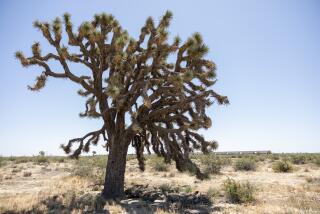Woodpeckers Inflict Costly Damage Upon Power Poles : Utilities: Edison officials complain that the birds can dramatically carve up the life span of the wooden posts. But avian enthusiasts question the extent of the problem.
- Share via
All across Ventura County, they are drilling.
For some residents, the sound of a woodpecker rat-a-tatting into a tree is a mere annoyance.
To Southern California Edison, however, it is a growing expense that the company has tried to control.
One anti-woodpecker tactic is to spray chemicals on the power poles to harden the wood so that the birds go elsewhere to do their pecking.
Another approach is to wrap the poles in wire mesh, so that the birds can’t get their beaks up to the wood.
“Woodpeckers cause a lot of damage to utility poles,” said David Himmel, spokesman for Edison. “They use the poles to store food.”
In certain areas of Ventura County, such as Ojai and Thousand Oaks, where there are high concentrations of woodpeckers, poles are so heavily carved that they need to be replaced every five years, Himmel said.
Typically, a utility pole can last up to 20 years, Himmel said.
To slow the damage, Edison fends off the woodpeckers with its wood-hardening chemicals and wire mesh defenses. But those are only stop-gap measures, Himmel conceded.
The only sure-fire way to keep woodpeckers from hacking away power poles, however, is to make the poles less appealing by switching to Fiberglas poles. But for now, they are considered too expensive, Himmel said.
Bruce Morris, an Edison maintenance employee, said he is appalled by the damage on some poles he sees in wilderness areas.
“Sometimes it’s like a Swiss-cheese pole, full of holes that are filled with acorns,” Morris said.
But bird experts said they question the extent of such damage.
Linda O’Neil, a bird-watcher from Ventura, said she has not seen the damage firsthand, but doubts if it is really necessary for Edison to replace utility poles.
And Edison officials say residents sometimes complain that the power company is making life too tough on the woodpeckers.
“Sometimes people get upset because we are taking the birds’ home away,” Morris said. “But we need to do that for our own safety.”
Morris said a pole can be so damaged that workers cannot make needed repairs.
“If we let it go too long, the pole will either fall down or be so deteriorated that it would be impossible for us to climb.”
Poles damaged by woodpeckers can also cause power failures, creating blackouts that last for hours, Morris said.
But utility poles are not the only target for woodpeckers.
Although it is not common, woodpeckers also attack houses, said Robert Mesta, an ornithologist with the U. S. Fish and Wildlife Service.
“We get a handful of calls a year by residents asking what to do about woodpeckers which have a nest or store food in a home,” Mesta said.
Woodpeckers can cause serious damage to homes by carving holes into the wood, allowing small insects and mice to come in through the roof, he said.
Mesta said he usually refers callers to Fish and Wildlife law enforcement officials, who can advise residents how to get rid of woodpeckers without violating the law, protects woodpeckers from being shot or from having their nests destroyed.
“There are a lot of things that you cannot do to a woodpecker,” he said. “I usually recommend that people contact a law enforcement branch or a wildlife group, which can do everything from patch up a hole or relocate the woodpecker and the nest to another area.”
O’Neil said one of the most common ways to scare away woodpeckers is to hang flashy dangling items around the target area.
As the current spring nesting season ends, Edison’s workers and residents should watch out. Woodpeckers will be out teaching their newborns how to make holes, O’Neil said.
“They are all feeding birds right now,” O’Neil said. “Early June, July, they will be out with their family showing them how to build holes.”
More to Read
Sign up for Essential California
The most important California stories and recommendations in your inbox every morning.
You may occasionally receive promotional content from the Los Angeles Times.













